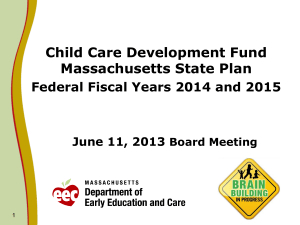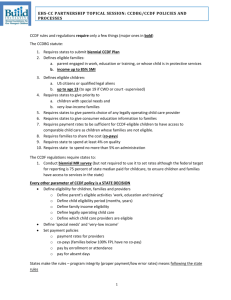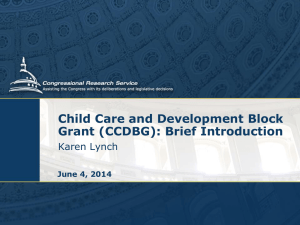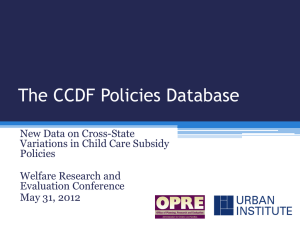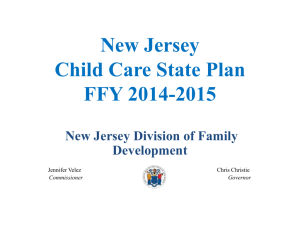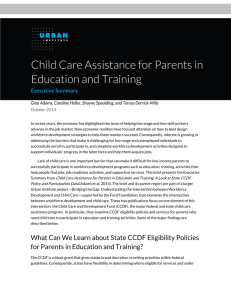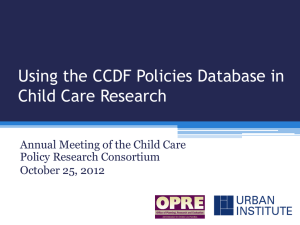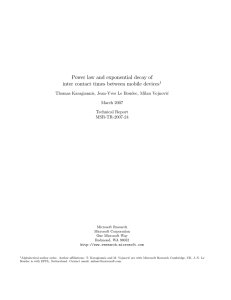Child Care Development Fund – State Plan for Federal Fiscal
advertisement
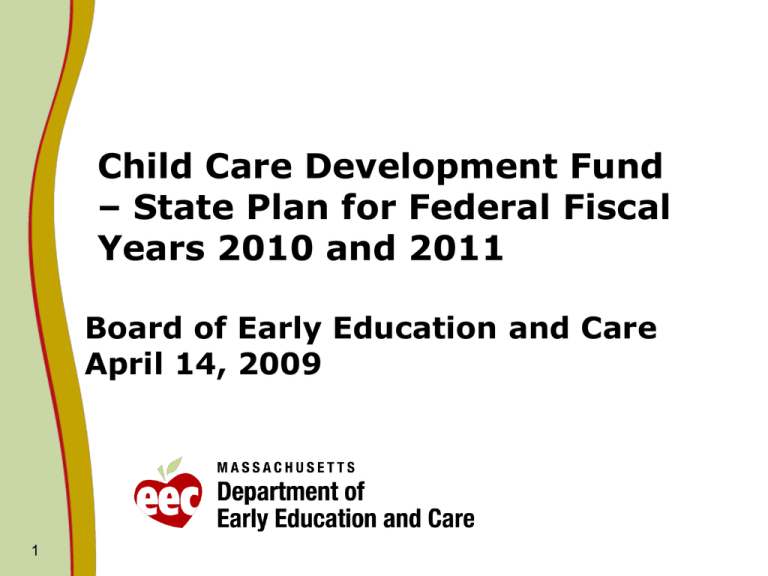
Child Care Development Fund – State Plan for Federal Fiscal Years 2010 and 2011 Board of Early Education and Care April 14, 2009 1 Discussion Overview CCDF State Plan Requirement Estimated CCDF Funding CCDF Goals and Purposes 2 CCDF Goals CCDF Purposes CCDF Eligibility Requirements and Flexible Administration CCDF Contents CCDF Updates Key Policy Directions/Themes FY2007-2012 CCDF Plan: Next Steps and Submission Timeline CCDF State Plan Requirement In order to receive CCDF funds, Federal law requires all States to submit a State Plan every two years The Lead Agency must submit a new State Plan prior to the expiration of the current Plan in order to continue receiving CCDF Funds 3 See 45 CFR Part 98.13(c); 98.17(a) See 45 CFR Part 98.17(b) Estimated CCDF Funding 4 EEC estimates that over $535 million in federal and state funds will be available for child care services in FY10. CCDF law places certain limitations and requirements on Lead Agencies charged with administering child care programs and services funded with federal funds. For example: At least 4% must be spent on activities to improve the quality of child care No more than 5% may be spent on administrative expenses Not less than 70% shall be used for families: (1) on TANF; (2) transitioning off TANF; or (3) at risk of receiving TANF Congressional earmarks require states to spend sum certain amounts on quality, in addition to the 4% requirement, on: • Infant-Toddler activities • General child care quality initiatives CCDF Goals 5 Federal law identified the following 5 goals in creating the CCDF block grant: Allow each State maximum flexibility; Promote parental choice; Encourage States to provide consumer education to help parents make informed choices about child care; Assist States to provide child care to parents trying to achieve independence from public assistance; and Assist States in implementing the health, safety, licensing and registration established in regulations. CCDF Purposes 6 Federal lawmakers established that the purpose of CCDF is to increase the availability, affordability and quality of child care by: Providing low-income families with the financial resources to find and afford quality child care Enhancing quality and increasing the supply of child care Providing parents with a broad range of options Strengthening the role of family Improving the quality and coordination of child care Increasing the availability of early childhood development programs and before/after school services CCDF Eligibility Requirements and Flexible Plan Administration Although Federal guidance grants great flexibility to States in the design and implementation of their CCDF State Plan, the regulations do contain certain minimum requirements For example, in order to be eligible for child care services funded by CCDF, a child must: be under 13 years of age, or under the age of 19 if special needs; must reside with a family whose income does not exceed 85% of the state’s median income; and must either reside with a parent or parents who are working or attending a job training or educational program or be receiving protective services. 7 CCDF Contents Part 1: Administration Part 2: Developing the Child Care Program Part 3: Child Care Services Offered 3.2 -- Payment Rates for the Provision of Child Care* Part 4: Parental Rights and Responsibilities Part 5: Activities & Services to Improve the Quality and Availability of Child Care Part 6: Health and Safety Requirements for Providers *Market Rate Study section to be completed week of April 20th 8 CCDF Updates The New CCDF Plan references specific achievements, in line with the Board’s Strategic vision, including: 9 Quality improvements: Regulation Reform; UPK Expansion and Policy Change; UPK Implementation Evaluation; Early Childhood Mental Health Funding; QRIS; and Early Childhood Accountability System – Technical Assistance Grant Family Support, Access and Affordability: Increased Access for MA Homeless families; Cost of Living Increase in MA SMI; and New procurement for Income-Eligible contracts Workforce Improvements: Early Recommendations by Education and Care and Out of School Time Workforce Development Task Force; New guidelines for ECE Scholarships; and New Professional Development calendar External and Internal Communications Strategy: New Family Guide released – “Learn and Grow Together”; Progress on translation of EEC materials; and Enhanced Child Care Search on website Infrastructure Improvements: Developing an upgraded and unified IT System; and Launched Single-Sign On web applications Key Policy Directions/Themes FY2007-2012 10 Streamlining access/making system more responsive for families Improving translation services Allowing communication via mail Streamlining documentation reviews Reassessing eligibility annually Extending SACC through age 13 Encouraging interagency collaborations Improving services for families involved with multiple state agencies Integrating quality measures to ensure low-income families have access to higher quality programs Income Eligible contract requirements Focusing on UPK Commissioner districts Improving equity & transparency for families and ease of use Developing Unified IT System and Single Sign-On Increasing accountability of providers and families Integrating IAP approach into monitoring Converting locally managed funds to centralized system CCDF Plan: Next Steps and Submission Timeline 11 April 14th Board Meeting – Initial Board Discussion April 17th– Submit plan to Planning & Evaluation Committee (PEC) April 24th– Receive comments/ edits from PEC April 28th- Post Document to Board Website for full review May12th Board Meeting - Board votes to put plan out for public comment End of May – Public Hearing(s) are to be held First Week of June– Summarize and review public comments and revise plan, if needed; post final draft to Board website in preparation of the June Board meeting June 9th Board Meeting –Board votes to approve plan and authorize submission to ACF July 1st – CCDF State Plan due to ACF
